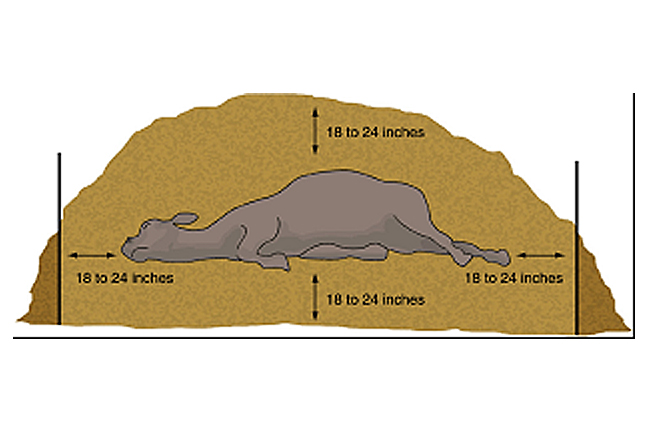
Agricultural News
Post-Tornado Composting May be Solution for Dead Livestock Disposal
Tue, 21 May 2013 10:50:06 CDT

Devastating storms such as the May 20 tornado that struck Moore highlight the need to act quickly to dispose of livestock and other large animal carcasses at a time when necessary equipment may be tied up with high-priority search-and-rescue or recovery efforts for people.
"When burial, incineration or rendering are not available options, composting animal mortalities can be an inexpensive, biologically secure and environmentally sound approach to addressing the issue of carcass disposal," said Josh Payne, Oklahoma State University Cooperative Extension animal waste management specialist headquartered in Muskogee.
Composting is a controlled biological decomposition process that converts organic matter into a stable, humus-like product. The carcass, which is a nitrogen source, is covered with a bulking carbon-source agent such as wood shavings, thereby promoting the proper carbon-to-nitrogen ratio required by microorganisms to successfully decompose the carcass while absorbing excess moisture and filtering odor.
For smaller carcasses, a bin system can be utilized that layers carcasses with bulking agents such as chopped straw, poultry litter and wood shavings. The high temperatures - 130 degrees Fahrenheit to 150 degrees Fahrenheit - achieved through proper composting will destroy most pathogens.
"Microorganisms will degrade the carcass, leaving only a few small bone fragments that are brittle and break easily," Payne said. "This valuable by-product then can be applied as a fertilizer source, adding nutrients and organic matter to the soil or recycled for new compost piles."
Payne stressed proper management is key for composting to be effective. As with burial, site selection is important. The site should be located in an area that does not pose a risk to surface or groundwater contamination.
"Catastrophic losses are best composted in windrows of a bulking agent because of the increased quantity of carcasses," Payne said. "Height, width and length of these windrows are dependent on the size and amount of carcasses to be composted."
For both routine and catastrophic composting, piles must be appropriately managed to achieve proper decomposition and prevent scavenger invasion.
In addition, it is important to note the heavy equipment required for burial of animal carcasses may not be a recommended option on saturated soils as equipment may get stuck or cause extensive rutting of fields.
"As the Oklahoma Cooperative Extension Service and state veterinarian have stressed for many years, emergency management plans should be developed and in place for catastrophic losses," Payne said. "It's also important to note that with large numbers of mortality, it may be necessary to employ more than one carcass disposal option."
Proper livestock and poultry mortality disposal is essential to the sustainability and environmental stewardship of farming and ranching operations, with state laws regulating disposal methods.
"When properly managed, composting livestock mortalities is a safe, effective option for most agricultural producers to consider," Payne said.
Additional information about dead animal composting and other carcass disposal options are available online at http://osufacts.okstate.edu through OSU Division of Agricultural Sciences and Natural Resources Extension fact sheets BAE-1748, "Proper Disposal of Routine and Catastrophic Livestock and Poultry Mortality," and BAE-1749, "On-Farm Mortality Composting of Livestock Carcasses."
by Donald Stotts, Communications Specialist, Oklahoma State University
WebReadyTM Powered by WireReady® NSI
Top Agricultural News
More Headlines...




















